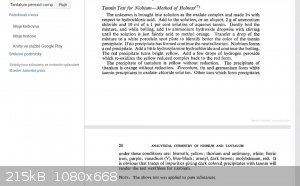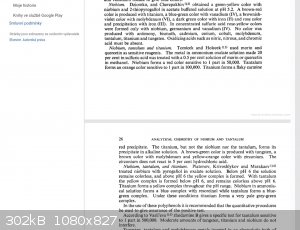j_sum1
Administrator
       
Posts: 6218
Registered: 4-10-2014
Location: Unmoved
Member Is Offline
Mood: Organised
|
|
Things to do with tantalum
I have several strips of what I believe is tantalum. (There is some uncertainty as a result of some wayward labels.)
I am wondering if there are some interesting salts or other compounds I might make. I guess a good start would be a test to confirm the identity of
the material. A quick search did not yield anything particularly exciting. And quite a few compounds are reported as unstable and/or requiring airless
conditions to synthesise and store.
Any ideas?
|
|
|
Admagistr
Hazard to Others
  
Posts: 348
Registered: 4-11-2021
Location: Central Europe
Member Is Offline
Mood: The dreaming alchemist
|
|
Quote: Originally posted by j_sum1  | I have several strips of what I believe is tantalum. (There is some uncertainty as a result of some wayward labels.)
I am wondering if there are some interesting salts or other compounds I might make. I guess a good start would be a test to confirm the identity of
the material. A quick search did not yield anything particularly exciting. And quite a few compounds are reported as unstable and/or requiring airless
conditions to synthesise and store.
Any ideas? |
I would make a LiTaO3 crystal and investigate its extremely strong pyroelectric properties.It is also used for nuclear fusion on a microscale.
|
|
|
Bedlasky
International Hazard
    
Posts: 1219
Registered: 15-4-2019
Location: Period 5, group 6
Member Is Offline
Mood: Volatile
|
|
Tantalum produce colored precipitates with tannin, quercetin and pyrogallol. They are one of few colored Ta compounds which can be made from aqueous
solution.
 
|
|
|
woelen
Super Administrator
        
Posts: 7976
Registered: 20-8-2005
Location: Netherlands
Member Is Offline
Mood: interested
|
|
Interesting finds.
I have a few grams of Ta2O5, and tried to dissolve a pinch of that some years ago, but no luck. Not even hot concentrated solution of NaOH could do
the job. What soluble Ta-salts can be used for this kind of experiments?
|
|
|
Admagistr
Hazard to Others
  
Posts: 348
Registered: 4-11-2021
Location: Central Europe
Member Is Offline
Mood: The dreaming alchemist
|
|
Quote: Originally posted by woelen  | Interesting finds.
I have a few grams of Ta2O5, and tried to dissolve a pinch of that some years ago, but no luck. Not even hot concentrated solution of NaOH could do
the job. What soluble Ta-salts can be used for this kind of experiments? |
Hi,I think you can't get it from solution,you probably have to melt Ta2O5 with a mixture of anhydrous alkaline hydroxide and nitrate and then get it
in soluble form;-)
|
|
|
Bedlasky
International Hazard
    
Posts: 1219
Registered: 15-4-2019
Location: Period 5, group 6
Member Is Offline
Mood: Volatile
|
|
Woelen: Wiki says that Ta2O5 dissolves in HF, but question is at what conditions and speed of reaction.
I agree with Admagistr - dissolve it in molten NaOH. Or you can try molten NaHSO4. J_sum have easier job, metallic tantalum should dissolve in mixture
of HNO3 and HF or alkali fluoride.
|
|
|
j_sum1
Administrator
       
Posts: 6218
Registered: 4-10-2014
Location: Unmoved
Member Is Offline
Mood: Organised
|
|
The only fluoride I have is CaF2. Something tells me that won't work. Could I get away with aqua regia?
|
|
|
Bedlasky
International Hazard
    
Posts: 1219
Registered: 15-4-2019
Location: Period 5, group 6
Member Is Offline
Mood: Volatile
|
|
Nb and Ta are soluble only in the presence of fluoride which destroy protective (and quite inert) oxide layer. Try that mixture of CaF2+HNO3. Nitric
acid is strong acid, it should displace fluoride from CaF2. Add small amount of mixture and one Ta strip in to the test tube, heat it on water bath in
well ventilated area. You will see if Ta is dissolving or not.
And btw you can try anodic oxidation to create colorful oxide layer on the metal surface. Woelen did something similar with Nb.
https://woelen.homescience.net/science/chem/exps/niobium/ind...
|
|
|
j_sum1
Administrator
       
Posts: 6218
Registered: 4-10-2014
Location: Unmoved
Member Is Offline
Mood: Organised
|
|
Ok. Well I guess that forms the basis of a test to confirm the identity of the strips.
I might get a chance to try this out tomorrow.
I have some gallic acid on hand so I should play around with that tannin idea if I get something in solution.
It seems that doing something with is a bigger challenge than I snticipated. Could be fun. Or frustrating. Or both.
|
|
|
Bedlasky
International Hazard
    
Posts: 1219
Registered: 15-4-2019
Location: Period 5, group 6
Member Is Offline
Mood: Volatile
|
|
You can try aqua regia first, most other metals should dissolve in it. If it doesn't react, you have Nb or Ta, Nb(V) can be reduce by zinc in to
Nb(IV), Ta(V) can't be reduced.
|
|
|
blogfast25
International Hazard
    
Posts: 10562
Registered: 3-2-2008
Location: Neverland
Member Is Offline
Mood: No Mood
|
|
Don't forget NH4HF2, to 'poor man's HF'!
|
|
|
blogfast25
International Hazard
    
Posts: 10562
Registered: 3-2-2008
Location: Neverland
Member Is Offline
Mood: No Mood
|
|
Reference?
|
|
|
Bedlasky
International Hazard
    
Posts: 1219
Registered: 15-4-2019
Location: Period 5, group 6
Member Is Offline
Mood: Volatile
|
|
Remy's inorganic chemistry vol. 2. I have Czech translation in PDF, if you want I can post screenshot from it, but you must manually type it in to
translator.
|
|
|
blogfast25
International Hazard
    
Posts: 10562
Registered: 3-2-2008
Location: Neverland
Member Is Offline
Mood: No Mood
|
|
Quote: Originally posted by Bedlasky  | | Remy's inorganic chemistry vol. 2. I have Czech translation in PDF, if you want I can post screenshot from it, but you must manually type it in to
translator. |
My Czech isn't that bad, so go right ahead. Ta!
|
|
|
Bedlasky
International Hazard
    
Posts: 1219
Registered: 15-4-2019
Location: Period 5, group 6
Member Is Offline
Mood: Volatile
|
|
Here it is.

Btw. you can predict this behavior from the behaviour of tantalum's neighborhood.
Zr(IV) - can't be reduced to Zr(III) in aqueous solution, Nb(V) - can be reduced to air sensitive Nb(IV) by zinc powder, Mo(VI) - can be reduced to
Mo(V) by mild reducing agents (Mo(V) isn't oxidized by the air), to air sensitive Mo(IV) by strong reducing agents like TiCl3, SnCl2 etc., to very air
sensitive Mo(III) by zinc powder.
Hf(IV) - can't be reduced to Hf(III) in aqueous solution, W(VI) - can be reduced to air sensitive W(V) by zinc powder in HCl/H2C2O4 solution, to very
air sensitive W(IV) and W(III) by zinc/aluminium in hot concentrated HCl.
Ta(V) will be more difficult to reduce than Nb(V). Nb(V) is somewhere between Zr(IV) and Mo(VI) in redox behavior, so Ta(V) is somewhere between
Hf(IV) and W(VI). So you can suppose that reduction of Ta(V) to Ta(IV) in aqueous solution is a)impossible or b)need specific conditions and strong
reducing agent, similar to reduction of W(VI) to W(IV)/W(III).
|
|
|